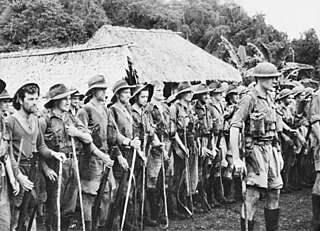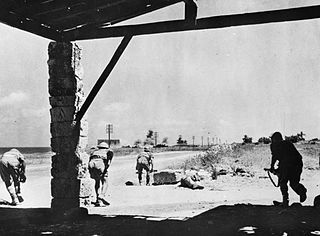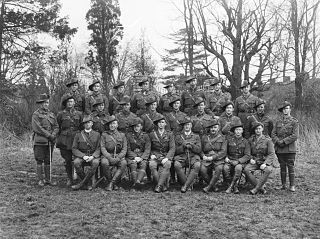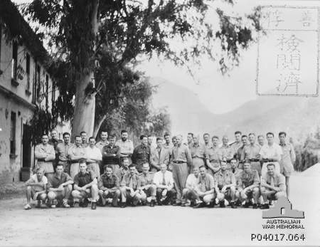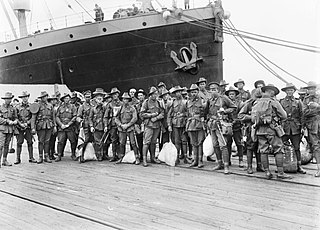| Honner Force | |
|---|---|
| Active | 1942 |
| Disbanded | September 1942 |
| Country | Australia |
| Branch | Australian Army |
| Type | Ad hoc composite force |
| Size | approx 500 men |
| Part of | 7th Division |
| Engagements | |
| Battle honours | No battle honours awarded |
| Commanders | |
| Notable commanders | Ralph Honner |
Honner Force was the name given to an ad hoc composite Australian Army force of approximately 500 men under the command of Lieutenant Colonel Ralph Honner, [1] which served in the New Guinea campaign in 1942 in World War II.

The Australian Army is Australia's military land force. It is part of the Australian Defence Force (ADF) along with the Royal Australian Navy and the Royal Australian Air Force. While the Chief of the Defence Force (CDF) commands the ADF, the Army is commanded by the Chief of Army (CA). The CA is therefore subordinate to the CDF, but is also directly responsible to the Minister for Defence. Although Australian soldiers have been involved in a number of minor and major conflicts throughout its history, only in World War II has Australian territory come under direct attack.

Lieutenant Colonel Hyacinth Ralph Honner DSO, MC, known as Ralph Honner, was a distinguished Australian soldier during the Second World War. He is considered particularly notable for his leadership during the Kokoda Track Campaign, during which he commanded the 39th Battalion, which fought a series of delaying actions as the Japanese advanced towards Port Moresby. In 1943 Honner was wounded during the fighting in the Ramu and Markham Valleys and, as a result, was discharged from the Army in early 1945. In his later life, he worked as an administrator on the War Pensions Assessment Appeal Tribunal. He was also active in the Liberal Party of New South Wales and served as the Australian ambassador to Ireland between 1968 and 1972. He died in 1994, aged 89.

The New Guinea campaign of the Pacific War lasted from January 1942 until the end of the war in August 1945. During the initial phase in early 1942, the Empire of Japan invaded the Australian-administered territories of the New Guinea Mandate and Papua and overran western New Guinea, which was a part of the Netherlands East Indies. During the second phase, lasting from late 1942 until the Japanese surrender, the Allies—consisting primarily of Australian and US forces—cleared the Japanese first from Papua, then the Mandate and finally from the Dutch colony.
It was formed on 11 September 1942, under 7th Australian Division Operational Instruction Number 10 and drew manpower from the 36th, 55th Battalion and 49th Battalions, which each provided approximately a company, plus a detachment from 2/6th Independent Company. [2] The force was sent out by the New Guinea Force via Laloki–Goldie River to cut the enemy line of communications between Menari and Nauro. Consisting mainly of eighteen- and nineteen-year-old militiamen who were barely trained and ill-equipped, Honner Force found it difficult to traverse the muddy tracks and dense jungle, however, by 19 September they had reached the vicinity of Omaramara. [3] The majority of the men were exhausted from the march, and the aerial re-supply that had been planned for them did not eventuate. As such they were unable to move beyond the limits of which ground supply could reach them. As the strategic situation around Kokoda had stabilised by then, it was decided that the force was in no condition to conduct offensive operations and they were subsequently disbanded shortly after with the men returning to their parent units without having seen action. [4]
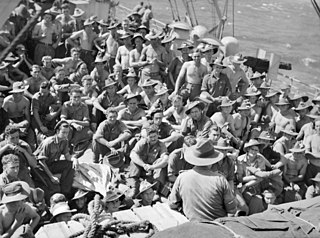
The 36th Battalion was an infantry battalion of the Australian Army. It was originally raised in 1916 as part of the First Australian Imperial Force during World War I. Throughout World War I the battalion served on the Western Front as part of the 9th Brigade, attached to the 3rd Division. Due to heavy casualties amongst the AIF and a decrease in the number of replacements arriving from Australia in 1918, the battalion was disbanded before the war ended in order to reinforce other units in France. The 36th Battalion was re-raised in 1921 as part of the Militia based in Sydney. During World War II the battalion was attached to the 14th Brigade and was initially used in a defensive role as a garrison unit in Australia before being sent to New Guinea in 1942. Throughout the course of the war in the Pacific, the 36th Battalion spent most of the 1942–45 period overseas in New Guinea and New Britain where they undertook operations against the Japanese. In June 1945 they were returned to Australia and shortly afterwards the battalion was disbanded.

The 55th Battalion was an infantry battalion of the Australian Army. Raised in 1916 for service during World War I the battalion served on the Western Front until the end of the war, before being briefly amalgamated with the 53rd Battalion and then being disbanded in 1919. In 1921, the 55th Battalion was re-raised and in 1927 adopted the title of the "New South Wales Irish Rifles". This designation was later changed to the "New South Wales Rifle Regiment" in 1930, before they were once again amalgamated with the 53rd, forming the 55th/53rd Battalion in 1937. In October 1941, during World War II, the two battalions were delinked and the 55th was later deployed to New Guinea, where they took part in the Kokoda Track campaign, fighting against the Japanese. Poorly prepared and trained, and lacking up to date equipment, they performed above expectations; however, they were amalgamated with the 53rd, which had not fared so well, once more in October 1942. The 55th/53rd subsequently took part in further campaigns in New Guinea and Bougainville before being disbanded in May 1946.
The 49th Battalion was an infantry unit of the Australian Army. Raised as part of the Australian Imperial Force during the First World War, the battalion fought along the Western Front between mid-1916 and late 1918, before being disbanded in early 1919. In 1921, it was re-formed as a part-time unit based in the state of Queensland. Throughout the 1930s, the battalion was merged a couple of times as a result of manpower shortages, but in early 1940, as Australia mobilised for the Second World War, the 49th was expanded and the following year deployed to New Guinea to undertake garrison duty. Following Japan's entry into the war, the 49th was committed to the fighting in the early stages of the New Guinea campaign, taking part in the Battle of Sanananda in December 1942, where it took many casualties and suffered heavily from disease. The battalion was withdrawn back to Australia in early 1943 and subsequently disbanded in July, with the majority of its personnel being redistributed to other units. During the post-war period, the 49th Battalion was subsumed into the Royal Queensland Regiment, existing between 1966 and 1997, before being merged with the 25th Battalion to form the 25th/49th Battalion, Royal Queensland Regiment.
